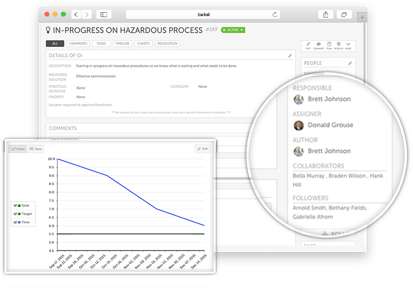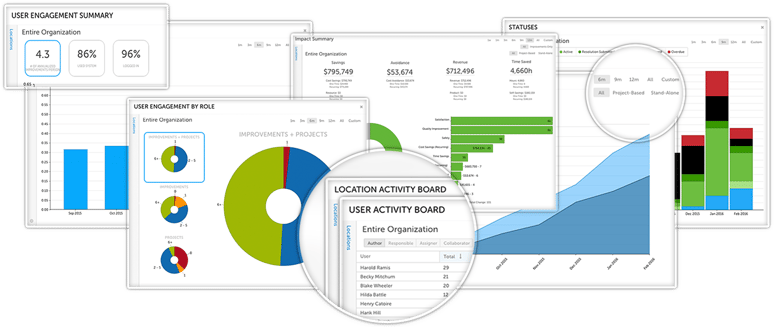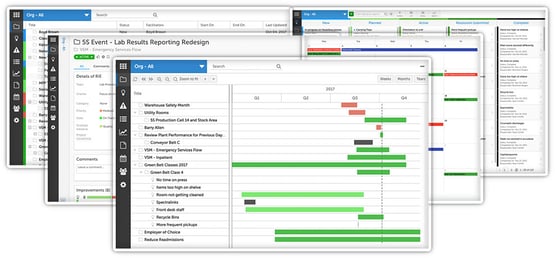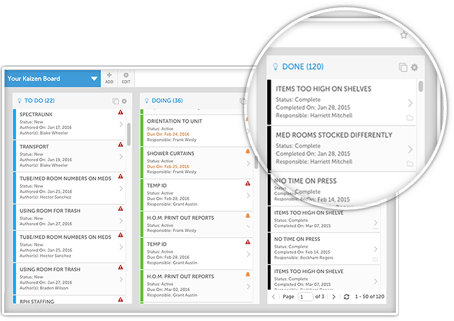 Kaizen boards are a fantastic addition to any improvement program. They arrange information visually so that a quick glance provides useful information about the progress of improvement projects. They are popular in every industry from healthcare to construction. In terms of implementing a Kaizen board, there are really two choices. A physical board that hangs on a wall in or near the workspace or an electronic Kaizen board that can be accessed from computers or mobile phones.
Kaizen boards are a fantastic addition to any improvement program. They arrange information visually so that a quick glance provides useful information about the progress of improvement projects. They are popular in every industry from healthcare to construction. In terms of implementing a Kaizen board, there are really two choices. A physical board that hangs on a wall in or near the workspace or an electronic Kaizen board that can be accessed from computers or mobile phones.
While paper boards make nice artifacts, there are a bunch of things that only their digital counterparts can do.
Here are our top 10.
1 – Be accessible from anywhere.
When you implement a digital Kaizen board, particularly one that lives in the cloud, you suddenly make your board available from anywhere your team happens to be. People who work remotely some or all of the time now have access to the same information as in-office workers. Folks who are traveling, or who just get a great idea for improvement after hours, can just log in to their mobile device and participate in positive change.
 2 – Enable cross-functional collaboration.
2 – Enable cross-functional collaboration.
Some improvement work requires the effort of people from more than one department or physical location. A single, organization-wide platform for Kaizen makes it possible for people to work together regardless of their department. Everyone can see what is going on throughout the organization, not just in their own silo.
3 – Generate alerts that trigger action.
Paper boards are very passive. They can’t sound an alarm or chime in with a warning if a due date is missed or progress has stopped. Digital ones, on the other hand, have notification and alert capabilities to remind team members and managers when tasks are due.
4 – Calculate impact.
One of the most important, and often overlooked responsibilities related to improvement is measuring the impact of each project on business goals like reduced cost, improved satisfaction, or fewer defects. Only by gathering this information can

5 – Broadcast success.
Speaking of success, celebrating it is essential in a culture of Kaizen. When someone implements an improvement that works, the good word should be spread far and wide. The best Kaizen software solutions have broadcasting features built-in so that recognition becomes a standard part of the improvement process.
6 – Create a repository of knowledge.
There’s no sense in reinventing the wheel. Unfortunately, that happens a lot with paper Kaizen boards because they only represent a snapshot in time. Once an improvement is completed and removed from the board, it no longer serves as a teacher for future improvement work. In the digital world, that doesn’t happen, and information lives on to tell the tale. People can learn from the work done in the past and by other teams.
 7 – Adapt to each person.
7 – Adapt to each person.
Not everyone needs the same view. Some people may be particularly interested in just a few projects, while leaders want an easy way to visualize work across the entire organization. Digital Kaizen boards make it possible for each person to have a view that is precisely relevant to them.
8 – Search the database.
The ability to search the database for similar problems or desired results can go a long way in speeding the path to improvement. Only an electronic database makes this possible and easy.
9 – Set a standard.
Digital Kaizen boards set a standard for how improvement ideas will be captured, how projects will be managed, and reports will be produced. They help reinforce Kaizen culture by getting everyone to use the same language for improvement.
 10 – Ensure more useful meetings.
10 – Ensure more useful meetings.
Often times teams “huddle” around the physical Kaizen board for a daily or weekly chat about the projects underway. (Kaizen boards are often called Huddle boards.) This is great for the folks in the room, but it can leave out relevant stakeholders who aren’t standing there. With a digital board, everyone who needs to be involved in the meeting can participate fully using a conference call.
These days, if it is essential, it is managed in a software solution. We’d argue that improvement work is among the most critical work of all, so a digital Kaizen board makes all the sense in the world.



Add a Comment